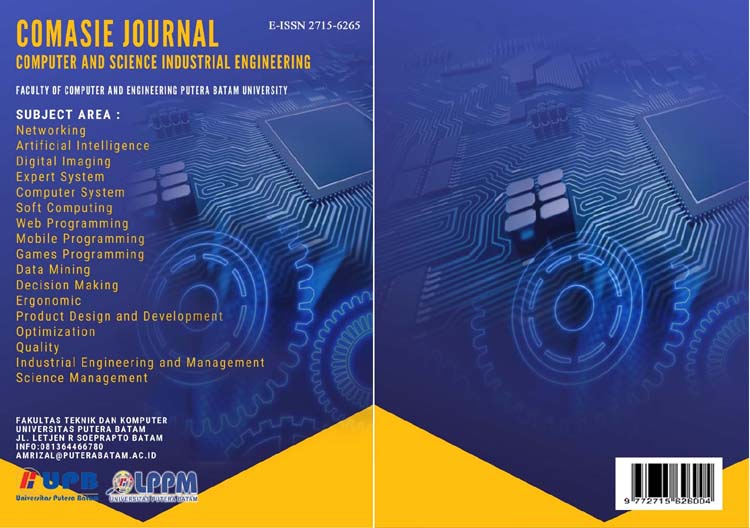SISTEM PAKAR MENDIAGNOSIS KERUSAKAN PADA KOMPUTER DENGAN MENGGUNAKAN METODE FORWARD CHAINING BERBASIS WEB
DOI:
https://doi.org/10.33884/comasiejournal.v11i2.9051Keywords:
Computer Damage Diagnosis; Expert system; Forward Chaining; Web Based.Abstract
Along with the increasingly rapid development of technology in all aspects of life, it can be seen from the application of computerized system technology. Basically, computer damage problems are the most frequently encountered cases, such as slow computers when reading data, missing icons on the desktop, system application crashes or files that cannot be run, or error messages appearing that are not understood, these are the problems that arise It often has fatal consequences that interfere with the work or activities being carried out. Broadly speaking, computer damage problems can be divided into two categories, namely hardware damage and software damage. The purpose of this research is to diagnose damage to computers so that it can help computer users (users) to overcome problems or damage to computer hardware (hardware) and computer software (software), so as to save time and repair costs.
References
Alindi, D. Y., Idmayanti, R., & Lestari, T. (2023). Penerapan Sistem Pakar Diagnosa Penyakit Pada Tanaman Cabai Menggunakan Metode Forward Chaining Berbasis Android. JITSI : Jurnal Ilmiah Teknologi Sistem Informasi, 4(2), 74–81. https://doi.org/10.30630/jitsi.4.2.117
Andriyani, N., Irawan, D., & Maseleno, A. (2021). THE IMPLEMENTATION OF WEB-BASED FORWARD CHAINING AS AN EXPERT SYSTEM FOR DIAGNOSIS OF CATTLE DISEASE IN CENTRAL LAMPUNG ( CASE STUDY : CATTLE FARM IN BANJAR SARI ). August, 45–58.
Anggraini, Y., Indra, M., Khoirusofi, M., Azis, I. N., & Rosyani, P. (2023). Systematic Literature Review : Sistem Pakar Diagnosa Penyakit Gigi Menggunakan Metode Forward Chaining. 1(01), 1–7.
Ayu, G., Sugiharni, D., & Informasi, S. (2017). Pemanfaatan Metode Forward Chaining Dalam Pengembangan Sistem Pakar Pendiagnosa Kerusakan Televisi Berwarna. 6, 20–29.
Info, A. (2018). Sistem pakar penanganan kerusakan komputer dan peripheralnya. 11(2).
Kasus, S., & Sungai, B. (2016). SISTEM PAKAR KERUSAKAN HARDWARE KOMPUTER. 18(2). https://doi.org/10.21063/JM.2016.V18.2.53-59
Kota, K., & Provinsi, D. I. (2018). PENERAPAN JARINGAN SARAF TIRUAN DALAM MEMPREDIKSI JUMLAH KEMISKINAN PADA. 05(01), 4–10.
Manajemen, J., Manekin, I., Maulida, A., Rahmatulloh, A., Ahussalim, I., Alvian, R., & Mulia, J. (2023). Analisis Metode Forward Chaining pada Sistem Pakar : Systematic Literature Review. 1(04), 144–151.
Mariana, A. W. (2019). Sistem Pakar Diagnosis Penyakit Tanaman Semangka Menggunakan Metode Certainty Factor. Jurnal Mahasiswa Teknik Informatika, 3(2), 72–77.
Saragih, S. P. (2019). TECHNOLOGY ACCEPTANCE OF DIGITAL PAYMENT SYSTEM PADA PELAKU UMKM DI KOTA BATAM. Computer Based Information System Journal, 7(2), 82–90. https://doi.org/10.33884/cbis.v7i2.1402 Saragih, S. P., & Nopriadi, N. (2019). Pengaruh Budaya Terhadap Actual Use Digital Payment System Pada Pelaku UMKM di Kota Batam. Journal of Applied Informatics and Computing, 3(2), 63–67. https://doi.org/10.30871/jaic.v3i2.1646
Metode, M., Factor, C., Prasetio, S. A., & Si, S. (2022). Pembuatan Website Untuk Deteksi Penyakit Umum. 7(1).
Mulyono, H., Darman, R. A., & Ramadhan, G. (2020). Sistem pakar diagnosa kerusakan pada laptop menggunakan metode certainty factor. 05, 98–103.
Pakar, S., Mendiagnosa, U., Komputer, K., Menggunakan, D., & Forward, M. (2014). Edu Komputika Journal. 1(2), 21–32.
Pramody, R., Industri, F. T., & Chaining, F. (2019). PENERAPAN METODE FORWARD CHAINING PADA SISTEM PAKAR UNTUK. 3(1), 269–276.
Puspita, E. S., & Yulianti, L. (2016). PERANCANGAN SISTEM PERAMALAN CUACA BERBASIS LOGIKA FUZZY. 12(1)














